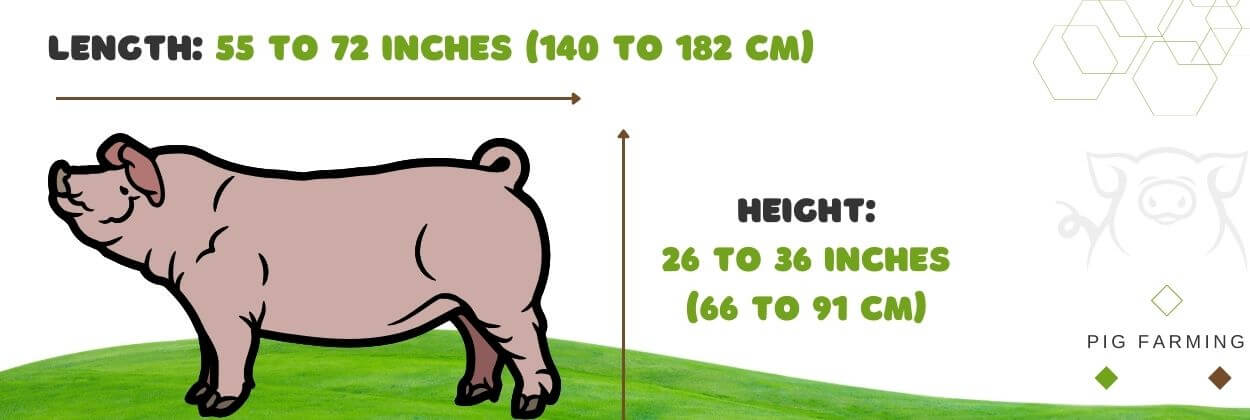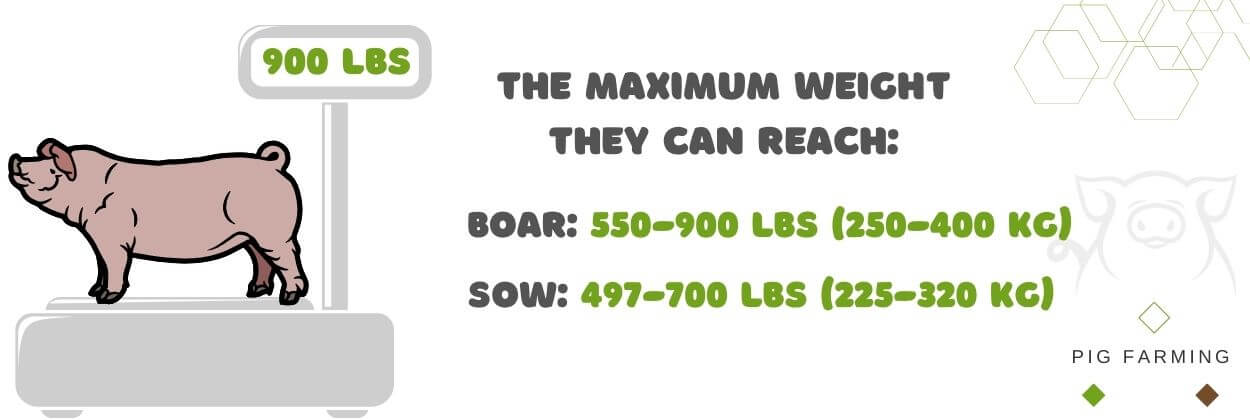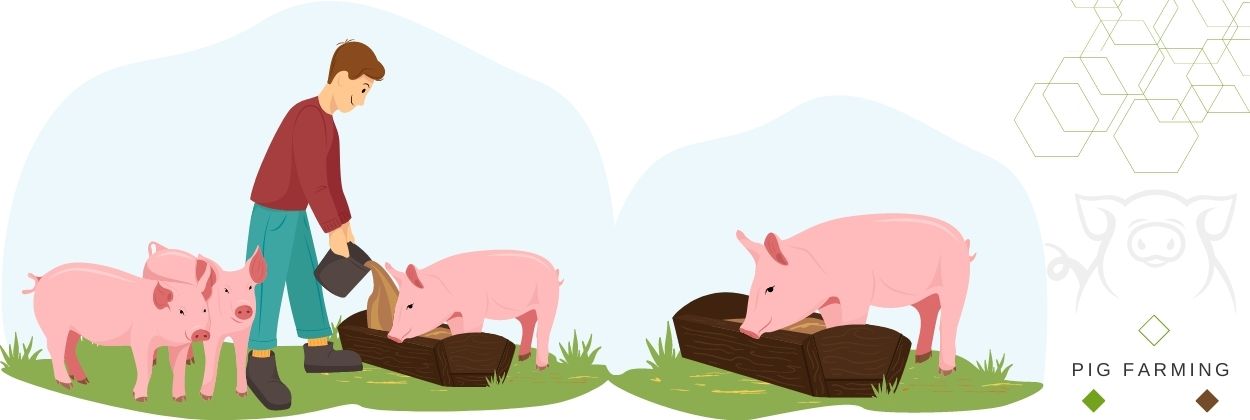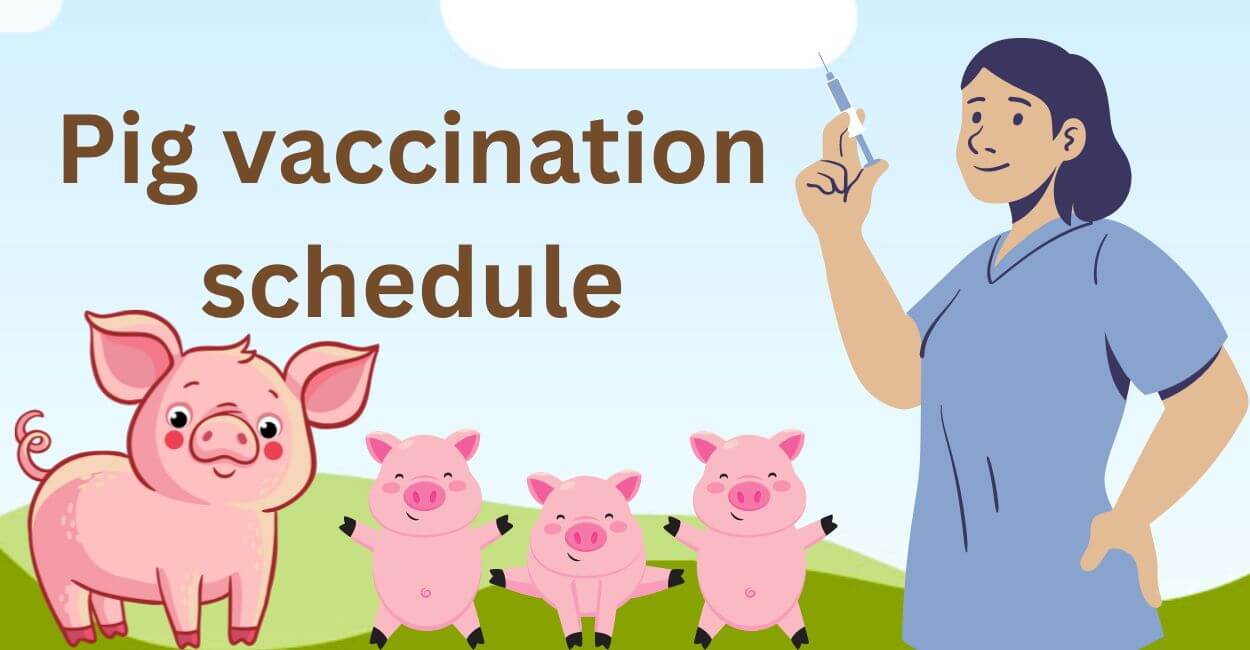
What is a Chester White pig?
Chester White is a domestic pig breed known as the Chester County White, originating between 1815 and 1818 in Chester County, Pennsylvania.
An unknown breeder created this pig by breeding large white pigs from the Northeast US with white boars from Bedfordshire County, England, imported by John Russell, Duke of Bedford.
In 1913, the Chester White Swine Records Association was created through the merger of two long-existing associations: the one from 1885 called the American Chester White Record Association and the one from 1890, The Standard Chester White Record Association.
Chester White Pig Characteristics
Physical Characteristics
The Chester White, with its distinct physique, can be easily recognized.
Let’s see what to look for when identifying a Chester White pig based on its physical characteristics.
Color
As its name suggests, the Chester White pig has a white color. The pig is entirely white with no solid color whatsoever.
Skin and Hair
The pig’s skin is smooth with no wrinkles, while the hair is short and white.
Head, Face, and Ears
The head of this pig is quite big, as well as its face. Its face is very expressive with a large mouth and two small eyes that are well set apart. The snout is large and has two big nostrils.
The ears are medium-sized and fall over their eyes without limiting their sight.
Neck and Shoulders
The neck is wide and thick, free of wrinkles, and the shoulders are very muscular.
Legs and Feet
The legs are of medium size, very sturdy, and provide excellent support for the overall weight of the body.
Chester White pigs walk on their tiptoes using only two middle toes to move and the other two to stay balanced.
Back and Belly
This pig has a straight back and a moderately wide, well-muscled loin. The belly is also straight with no protrusion.
Teeth
The adult Chester White has 44 teeth, whereas a piglet has only 28.
The teeth are similar to human ones as they are covered in enamel, which keeps them strong.
The piglets lose all their teeth, and by the time they are 12 months old, all of their baby teeth will be replaced.
Did you know: These pigs have strong teeth because they eat their food like people do? They have a digestive system similar to humans, so they can’t digest food that hasn’t been chewed. It has to be broken down in their mouth first.
Teats and Tail
Both the boar and the gilt have 6 functional teats on each side. The tail is long and twisted.
Size
The size of Chester White pigs is medium to large.

A Chester White measures 55 to 72 inches (140 to 182 cm) in length from snout to tail at maturity and 26 to 36 inches (66 to 91 cm) in height. Females are a bit smaller than males.
Lifespan
A Chester White pig can live for 6 to 10 years.
Compared to other pigs like Duroc or the American Guinea pig, the Chester White has a short lifespan.
Growth Rate
How fast do Chester White pigs grow?
Chester White pigs have a fast growth rate, reaching a substantial weight at 5 to 6 months of age.
Their growth rate is similar to that of Berkshire and Hampshire pigs.
Sexual maturity is reached at 7 months of age when the gilt can experience her first heat periods.
Weight

An adult Chester White boar can weigh up to 550-900 lbs (250-400 kg).
On the other side, females are a bit smaller than boars and can have a weight of up to 497-700 lbs (225-320 kg).
This pig can achieve a daily weight gain of up to 1.36 lbs (0.65 kg) and convert 1 lb (0.45 kg) for every 3 lbs (1.4 kg) of grain it consumes.
Slaughtered Time
Chester White pigs can be slaughtered starting at 5 months old, continuing until they are 8 months old, when they reach a weight of 250 to 360 lbs (115 to 160 kg).
The exact timing can be adjusted based on the specific production goals of the farmer and the market requirements. Some may prefer a slightly younger age for lighter pork cuts, while others may wait until the pigs reach a heavier weight for larger cuts and more substantial meat yield.
Temperament and Behaviour
Chester White pigs have a calm and docile temperament most of the time, but if treated badly, they can show signs of aggression.
However, as long as they are treated right, they are friendly animals and very cooperative, making them easy to handle despite their large appearance.
If introduced to humans from a young age, they can even recognize specific individuals. In terms of sociability, they do well with other animals and can coexist with other pigs, showing no signs of aggression.
As with any animal, individual temperament can vary, and factors such as handling, socialization, and the overall environment can influence the behavior of Chester White pigs.
In a peaceful and relaxed environment, with the right care and attention, they tend to stay friendly.
Regarding behaviors, these pigs enjoy grazing if left on pasture or any other area with grass. Also, they are curious animals and will always investigate each part of their living area.
Chester White Pig Meat
The meat from the Chester White pig is widely used in commercial pig meat production due to its characteristics, such as loin muscle, intramuscular fat percentage, flavor, and texture.

The meat of this pig has a high amount of intramuscular fat, similar to the meat of Duroc and Berkshire pigs.
It also has one of the highest pH values, indicating that it is better at holding water compared to pigs with lower pH values, such as Hampshire or Landrace. This means there is less water loss or dripping when storing and displaying fresh meat, improving cooking and curing.
| Breed | Intramuscular Fat Percent after harvest | pH |
|---|---|---|
| Duroc | 3.07 | 5.58 |
| Berkshire | 2.51 | 5.68 |
| Chester White | 2.39 | 5.70 |
| Spotted | 2.37 | 5.55 |
| Poland China | 2.18 | 5.61 |
| Hampshire | 2.09 | 5.58 |
| Landrace | 1.90 | 5.47 |
| Yorkshire | 1.70 | 5.47 |
The marbling of the meat makes it versatile for various cooking methods while offering a great taste.
The flavor can vary depending on the pig’s diet and living conditions.
The meat is also tender and juicy, suitable for a variety of cuts, including pork chops, ham, bacon, sausages, and ground pork. It is more tender than a Poland China and juicier than a Duroc.
| Breed | Tenderness | Juiciness |
|---|---|---|
| Berkshire | 7.3 | 6.1 |
| Hampshire | 6.8 | 5.8 |
| Chester White | 6.6 | 5.8 |
| Landrace | 6.6 | 5.0 |
| Duroc | 6.3 | 5.4 |
| Poland China | 6.3 | 5.4 |
| Yorkshire | 6.3 | 4.9 |
| Spotted | 5.9 | 5.3 |
Raising Chester White pig
Feeding

You can feed Chester White pigs with:
- Grains like corn, wheat, barley, and oats
- Vegetables, including leafy greens, carrots, beets, and other root vegetables
- Fruits like apples, watermelon, pears, and berries
- Nuts
- Dairy products
- Forage. If possible, allow the pigs access to pasture. Fresh grass has lots of nutrients alongside leaves, various flowers, worms, and bugs.
- Kitchen scraps with no sugar or salt.
Apart from these foods, you need to make sure that they have constant access to clean, fresh water.
These pigs need substantial amounts of water primarily for thermoregulation, preventing their bodies from overheating.
Environment
These pigs are highly adaptable and can be raised in a variety of environments like fresh pasture, which allows them to exhibit natural behaviors like grazing and foraging.
They can also thrive in confinement systems such as pens or barns used in commercial pig production for better management and control.
Climate
Chester White pigs do well in temperate and humid climates characterized by moderate temperatures.
They can also adapt to other diverse climatic conditions as long as they have what they need. For instance, they need a warm place to stay when it is cold and a wallow when it is hot to cool down.
Tip: These pigs do not sweat, and in hot climates, they are predisposed to heat stress. It is best to provide them with a wallow, as they will cover themselves in mud to thermoregulate their body temperature.
Shelter
These pigs, like many other pig breeds, need shelter. The shelter provides them with protection from various weather conditions. In cold weather, it offers warmth and protection against wind, rain, and snow. In hot weather, the shelter provides shade, minimizing the risk of heat stress and sunburns.
The shelter also offers security and reduces the risk of different diseases associated with wet and muddy living conditions.
If they have access to pasture, it’s recommended to use an electric fence, as they tend to try to escape.
Breeding
Breeding Chester White pigs is a straightforward process, although it requires planning and an understanding of pig behavior. Options include natural breeding by introducing a boar to a gilt or sow, or utilizing artificial insemination.
These pigs become sexually mature at 7 months old, but it is recommended to wait a bit longer, until 10 to 12 months, to ensure that the gilt is mature enough to bear pregnancy.
Once the pigs reach the right age, you need to select the appropriate gilt and boar. Unlike other pigs like Mangalica or Berkshire, in the case of Chester White, it is the boar that helps the gilt enter the heat period.
The Chester White boar starts emitting pheromones that attract gilts and sows around it. These pheromones are present in their saliva, and once the mating season starts, males begin salivating extensively to establish their territory.
Gilts and sows, in turn, use their snouts to detect the scent and actively seek out the male if they perceive him as a suitable mate.
The Chester White pig’s litter size is 8 to 10 piglets. The gestation period is 113 days, equivalent to 3 months, 3 weeks, and 3 days.
Gilts and sows exhibit great mothering skills and excel in taking care of their piglets after farrowing. They usually do not need assistance during farrowing or in raising their piglets, but it is recommended to monitor them.
Vaccination
Chester White pigs must be vaccinated against the most common pig diseases, especially when raised in confinement systems.

The vaccination chart for these pigs should include vaccines for pseudorabies, swine rotavirus, Lawsonia, PRRSV, Salmonella, and other standard pig vaccinations. It is important to administer periodic booster shots as well.
Chester White pig health issues
Some of the common health issues that can affect Chester White pigs include:
- Heat stress, especially in hot climates.
- Skin problems like sunburns due to their light skin color.
- Obesity if overfed.
- Parasitic infections from internal and external parasites.
- Respiratory infections, especially if raised in confined conditions.
- Vitamin C deficiency with symptoms like swollen joints, internal bleeding, or skeletal muscle bleeding.
Why should you raise Chester White pigs?
Profitability
Chester White pigs are often chosen for big pig farms because they get really big, grow quickly, and do well in closed systems like pens.
Because of all these qualities, these pigs can be a great way to make money. The starting costs are not too high compared to other pasture pigs.
A Chester White piglet costs between $190 to $250, and a fully grown pig can have a price range of $400 to $800, depending on things like age, gender, breeder, and weight.
They don’t need a lot of feed as they have an efficient feed conversion, which is good for your budget.
Plus, because they grow so fast if there’s a good market for meat products in your area like selling to local butchers or restaurants. Chester Whites are commonly used in the bacon industry, so finding buyers shouldn’t be a problem.
You can also make money by selling piglets or fully grown boars or sows to other interested pig farmers.
Personal Use
The Chester White pig is a good choice for homesteaders who want to obtain a large amount of meat yield for making their homemade products or for those with large families.
The amount of meat that comes from this pig is impressive and can be used in many ways, from making your ham or sausages to grilling it as different pork cuts.
If allowed to fatten a bit more, you can also get a substantial amount of fat to use in daily cooking.
Advantages and Disadvantages
| Advantages | Disadvantages |
|---|---|
| Fast growth rate, reaching market weight quickly. | Prone to obesity, which can lead to health issues. |
| Efficient feed conversion. | Prone to heat stress. |
| Great mothering skills. | Susceptible to sunburns and other skin diseases. |
| Large litter size. | Aggressive if mishandled. |
| High meat quality with good marbling. | Need shelter, wallow, and other setups in hot climates to protect themselves from the sun. |
| Large amount of meat yield. | |
| Well-adapted to various management systems. | |
| Docile and easy to handle. |


